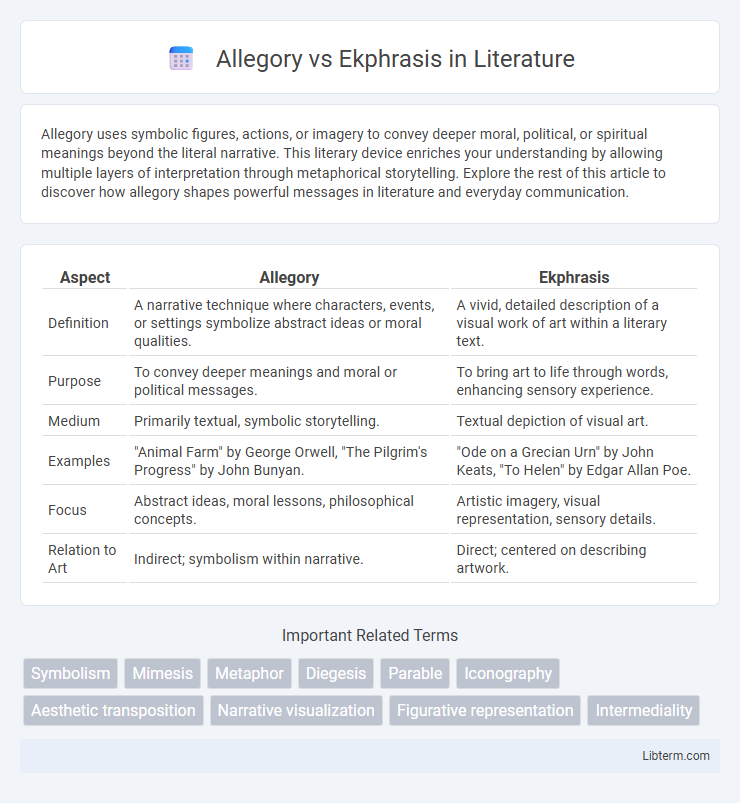Allegory uses symbolic figures, actions, or imagery to convey deeper moral, political, or spiritual meanings beyond the literal narrative. This literary device enriches your understanding by allowing multiple layers of interpretation through metaphorical storytelling. Explore the rest of this article to discover how allegory shapes powerful messages in literature and everyday communication.
Table of Comparison
| Aspect | Allegory | Ekphrasis |
|---|---|---|
| Definition | A narrative technique where characters, events, or settings symbolize abstract ideas or moral qualities. | A vivid, detailed description of a visual work of art within a literary text. |
| Purpose | To convey deeper meanings and moral or political messages. | To bring art to life through words, enhancing sensory experience. |
| Medium | Primarily textual, symbolic storytelling. | Textual depiction of visual art. |
| Examples | "Animal Farm" by George Orwell, "The Pilgrim's Progress" by John Bunyan. | "Ode on a Grecian Urn" by John Keats, "To Helen" by Edgar Allan Poe. |
| Focus | Abstract ideas, moral lessons, philosophical concepts. | Artistic imagery, visual representation, sensory details. |
| Relation to Art | Indirect; symbolism within narrative. | Direct; centered on describing artwork. |
Understanding Allegory: Definition and Origins
Allegory is a symbolic narrative technique where abstract ideas and principles are represented through characters, events, or imagery, often conveying moral, political, or spiritual meaning. Originating in ancient literature and philosophy, its roots can be traced back to works such as Plato's dialogues and Aesop's fables, where layered meanings encouraged deeper interpretation. This method contrasts with ekphrasis, which vividly describes a visual artwork to evoke sensory experience rather than convey symbolic narrative.
Ekphrasis Explained: Meaning and Historical Context
Ekphrasis is a literary device that vividly describes a work of visual art, aiming to evoke the essence and emotional impact of the artwork through detailed narrative. Originating in ancient Greek literature, it was prominently used by poets like Homer to bring paintings or sculptures to life in the reader's imagination. Historically, ekphrasis has evolved to bridge the gap between visual and verbal expression, allowing writers to explore complex artistic themes and deepen cultural appreciation.
Core Differences Between Allegory and Ekphrasis
Allegory conveys abstract ideas or principles through symbolic characters, events, or narratives, creating layered meanings that extend beyond the literal story. Ekphrasis specifically describes the vivid literary depiction of a visual artwork, aiming to capture its essence, details, and emotional impact through words. The core difference lies in allegory's broader symbolic representation within storytelling, while ekphrasis centers on the detailed verbal representation of a physical artistic object.
The Role of Symbolism in Allegory
Symbolism in allegory functions as a powerful tool to convey complex ideas through characters, events, and settings that represent abstract concepts, enabling multiple layers of interpretation. Unlike ekphrasis, which focuses on vivid descriptions of sensory experiences, allegorical symbolism emphasizes moral, philosophical, or political meanings embedded within a narrative structure. This symbolic framework allows allegories to communicate universal truths and critique societal issues indirectly, fostering deeper cognitive engagement in readers.
Visual Language in Ekphrasis
Visual language in ekphrasis vividly describes art through detailed imagery, bringing paintings, sculptures, or scenes to life within text. This technique emphasizes sensory experience and visual detail to evoke the artwork's essence, contrasting allegory's symbolic and abstract representation. Ekphrasis creates a direct sensory bridge between the viewer and the visual art, enhancing emotional and imaginative engagement.
Literary Examples of Allegory
Literary examples of allegory prominently include George Orwell's *Animal Farm*, where farm animals symbolize political figures and ideologies, illustrating the Russian Revolution and the dangers of totalitarianism. Another key example is John Bunyan's *The Pilgrim's Progress*, which uses a journey narrative to represent the Christian spiritual path and struggles with sin and redemption. These works exemplify allegory's power to convey complex moral, political, or spiritual messages through symbolic characters and events.
Notable Works of Ekphrasis in Literature
Ekphrasis in literature is exemplified by notable works such as John Keats' poem "Ode on a Grecian Urn," where vivid descriptions bring visual art to life through poetic language. Another prominent example is W.H. Auden's "Musee des Beaux Arts," which reflects on Pieter Bruegel's painting "Landscape with the Fall of Icarus," capturing the interplay between art and human experience. These works demonstrate how ekphrasis transforms static images into dynamic narratives, enriching literary expression with visual artistry.
How Allegory and Ekphrasis Shape Interpretation
Allegory shapes interpretation by embedding symbolic meanings within narrative elements, allowing readers to uncover deeper moral, political, or philosophical messages beneath the surface story. Ekphrasis enhances interpretation through vivid, detailed descriptions of visual art within a text, prompting readers to visualize and engage emotionally with both the artwork and the literary narrative. Together, allegory and ekphrasis expand interpretative layers by intertwining symbolic representation and sensory imagery, enriching the reader's understanding and experience.
Allegory vs Ekphrasis in Contemporary Art and Writing
Allegory in contemporary art and writing employs symbolic figures and narratives to convey complex ideas, often addressing social, political, or moral issues through layered meanings. Ekphrasis, by contrast, involves vivid, detailed descriptions of artworks within a literary text, creating a dynamic dialogue between visual and verbal forms that enhances sensory experience. Both techniques enrich contemporary creative expression by bridging visual and textual storytelling in distinct yet complementary ways.
Choosing Between Allegory and Ekphrasis for Creative Expression
Choosing between allegory and ekphrasis for creative expression hinges on the desired depth of symbolism and the focus on visual detail. Allegory employs extended metaphors to convey complex moral or political meanings, making it ideal for narratives that require layered interpretation. Ekphrasis vividly describes artworks within a text, enhancing sensory experience and bringing visual elements to life, suitable for emphasizing artistic imagery over thematic abstraction.
Allegory Infographic

 libterm.com
libterm.com